Great Danish Designers 101: H. W. Klein
Although Norwegian by birth, H.W. Klein is closely associated with the Danish modern style. His early education did not suggest a future career in furniture design, but the twists and turns of life led him in that exact direction.
H.W. Klein: Mathematician, Marine & Modern Designer
Henry Walter Klein was born in Norway in 1919. As a young man, he studied mathematics and linguistics. He would later serve in the Norwegian Royal Marines, where he developed an interest in cabinetmaking. In 1949, he moved to Denmark to study interior design at the Tekniske Skole in Frederikberg, where he trained under renowned designer Finn Juhl. Three years later, upon completing his education, he moved back to Norway to open his own business designing furniture and interiors. He returned to Denmark in 1960, working closely with furniture manufacturer Bramin. Very little documentation exists about Klein’s life, but some sources say his work for Bramin helped finance a newfound interest in plastics that would see him develop a new method for manufacturing plastic furniture. (http://bit.ly/1TtMZ07)
An historical record of his experiments with plastic is hard to come by, but we can look to Klein’s Danish inspired furniture—in demand and highly collectible still—for examples of his skill and artistry as a designer.
Klein’s Danish Design Aesthetic
Like his contemporaries, Klein followed the Danish design aesthetic of “well proportioned, well crafted forms” that seemed to float while also being perfectly grounded and balanced. The end result? Stunning visual impact, as the following examples show.
Looking at this piece, it’s reasonable to assume that Klein incorporated his background in mathematics in his designs. This rosewood desk combines rectangular, square, and triangular shapes in a fluid geometry:
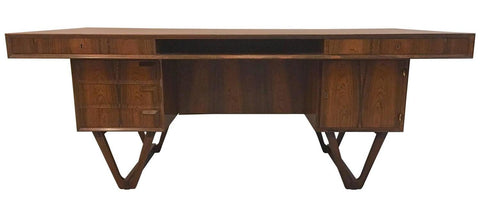
Image from 1stdibs.com.
Klein’s 4-seater sofa offers a similar aesthetic to the desk, with a long rectangular shape balanced on a spare base:
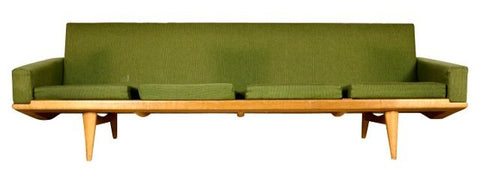
Image from One Kings Lane.
As the 4-seater sofa shows, Klein also followed the Danish trend of using colour and texture when designing furniture.
In her book Scandinavian Modern Home, Elizabeth Wilhide talks about the ways Scandinavian designers incorporated “domestic cheer” and “psychological warmth” as a counterbalance to the dreariness of winter’s short days and long nights. These feelings of warmth and cheer were achieved through the use of bold colours and textures like those seen in Klein’s 4-seater sofa. In addition to the green shown above, Klein used several other bright colours in his furnishings.
The colour in this ingeniously designed recliner is very typical of Danish modern furniture, adding panache and making a strong visual statement. The design itself creates a sense of comfort through both the warmth of the fabric and the curved shape that cradles the body.

Image from 1stdibs.com.
Klein favoured other primary colours in his living room furniture, seen in pieces that, like the recliner above, followed the Danish tradition of human-centred design:

Image from 1stdibs.com
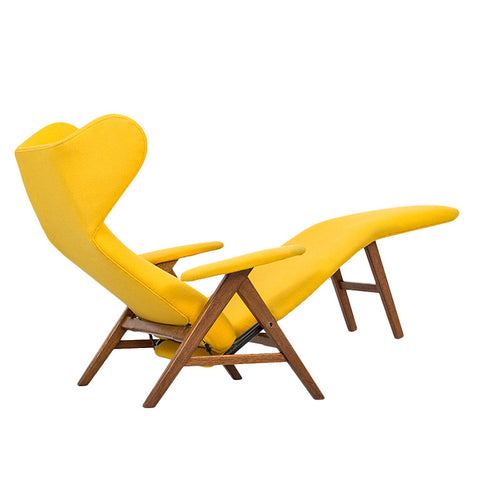
Image from 1stdibs.com.
This advertisement of Klein’s furniture, dating from 1962, shows how bold colours were combined to brighten a room:

Image from danish-modern.co.uk.
While not as warm as wool, leather is another textile that was commonly used by Danish designers in the mid-century period. Leather and leatherette fit beautifully with the Scandinavian aesthetic: they were visually appealing, very modern, and could be rendered in bold colours. Like other designers of the period, Klein used leather in both living room and dining room furniture.
When talking about Klein’s leather chairs we have to start with this one, a particularly striking example, shown in its original black leatherette:
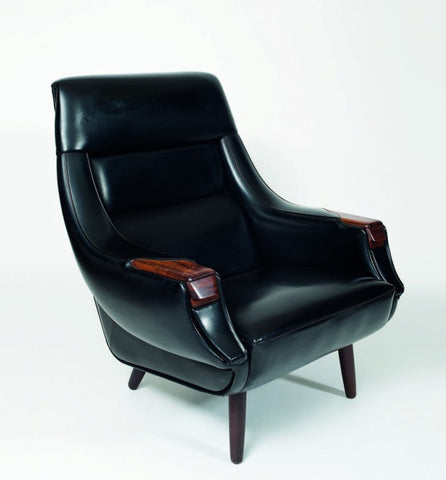
This armchair includes a feature that is not necessarily desired today, but would have had considerable appeal at the time of manufacture: a built-in ashtray.

Images from liveauctioneers.com.
Note the characteristic streamlined design—the armrests are so beautifully rendered, one would never even guess that anything lies within.
Danish designers in the mid-century period were known for reinventing classics, as Klein did with his leather swivel chair, shown below. This piece combines old and new: the bright colour and chrome are thoroughly modern while the tufted leather recalls more traditional leather armchairs.

Image from 1stdibs.com.
Leather was also a predominant feature of dining chairs from the mid-century period, and Klein made frequent use of it in this context. We have a beautiful example in stock at VHB: our set of six teak dining chairs with their original leatherette upholstery, shown below.
Klein designed many dining chairs, and all possess the hallmarks of Danish design: exquisite workmanship, fluid design, and an openness that visually lightens pieces made from heavy materials like leather and teak or rosewood. His chairs are also timeless, as seen in the fact that replicas of one of his more famous designs, sometimes referred to as the Bramin chair, are still produced today:
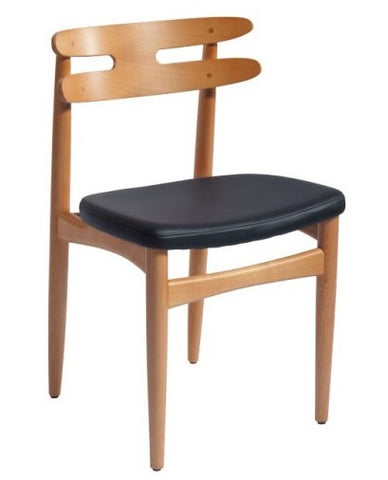
Image from Place Furniture, Australia
Also present in Klein’s work are the practicality and efficiency for which Danish design was known. These traits are apparent in his sideboards which maximized space and had a tidy appearance. This image shows a model in teak; its sliding doors glide neatly over the centre drawers to reveal additional storage.
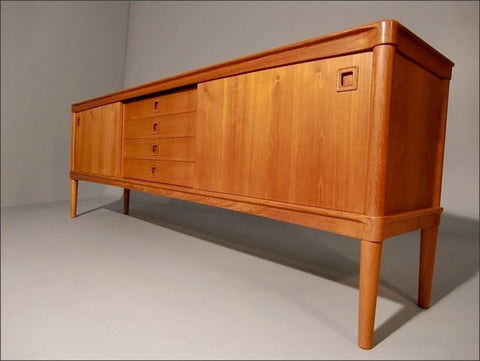
Image from room-of-art.de.
VHB has a similar sideboard in gorgeous rosewood:
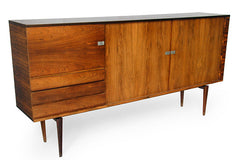

Images from scandinavianmod.com.
Here is another made of rosewood that emphasizes the beauty of the wood’s grain:
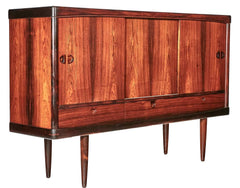
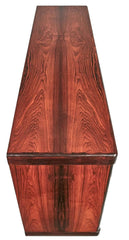
Images from 1stdibs.com.
Also in the spirit of maximizing space, Klein designed elegant dining tables with a minimalist aesthetic that could suit parties large and small, like this one from our collection, which includes leaves to extend the seating to ten people:
Klein was a prolific designer, known for dining room furniture, lounge chairs, coffee tables, sofas, and even fold-down sofa beds, as this 1961 advertisement shows.
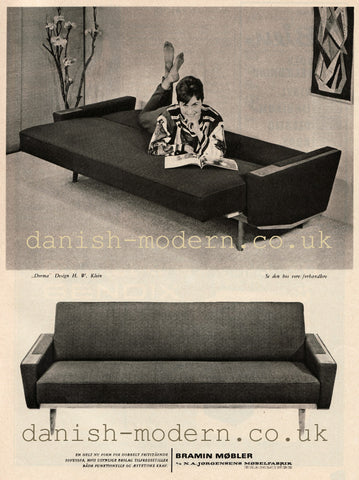
Image from danish-modern.co.uk.
As a Norwegian mathematician who became a quintessential Danish modern designer, H.W. Klein made his mark in a very singular way. Although very little has been written about him, his creative output speaks volumes about his talents as a craftsman.
Next in our series: Arne Vodder
Read more in this series: Johannes Andersen, Kai Kristiansen, Poul Cadovius, Poul Hundevad, Finn Juhl, and Kaare Klint.
This guest post was written by Crystal Smith of Pertingo Content Marketing.




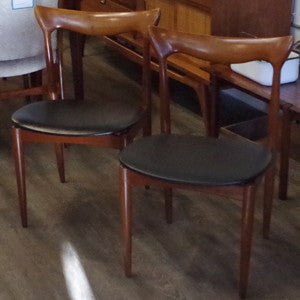

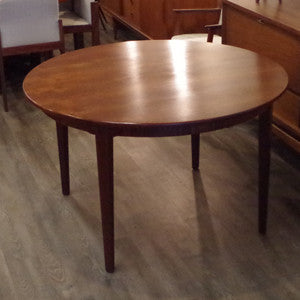
Leave a comment